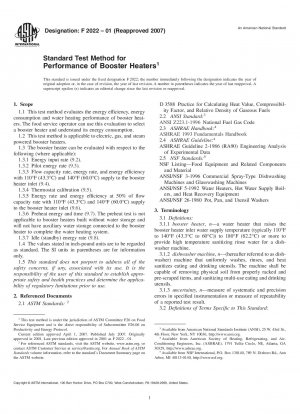ASTM F2022-01(2007)
Standard Test Method for Performance of Booster Heaters
- Standard No.
- ASTM F2022-01(2007)
- Release Date
- 2001
- Published By
- American Society for Testing and Materials (ASTM)
- Status
- Replace By
- ASTM F2022-01(2013)
- Latest
- ASTM F2022-01(2019)
- Scope
5.1 The energy input rate test is used to confirm that the booster heater is operating properly prior to further testing.
Booster heater flow capacity is an indicator of the booster heaterrsquo;ability to supply hot water for sanitation. The booster heaterrsquo;flow capacity can be used by the operator to determine the appropriate size booster heater for their operation. Booster heater energy rate is an indicator of the booster heaterrsquo;energy consumption during continuous water flow. The energy rate can be used by food service operators to estimate the energy consumption of the booster heater. Booster heater energy efficiency is a precise indicator of a booster heaterrsquo;energy performance during the continuous flow test. This information enables the food service operator to consider energy performance when selecting a booster heater.
Booster heater flow capacity at 50 % of the maximum capacity is an indicator of the booster heaterrsquo;ability to provide hot water for sanitation at this reduce flow rate condition. Booster heater energy efficiency at a flow rate of 50 % of maximum capacity is an indicator of a booster heaterrsquo; energy performance at this flow rate. The booster heater outlet temperature during the capacity test at a flow rate of 50 % of maximum capacity is an indicator of the booster heaterrsquo;temperature response at this reduced flow rate.
Preheat energy and time can be useful to food service operators to manage power demands and to know how quickly the booster heater can be ready for operation.
Idle energy rate and pilot energy rate can be used to estimate energy consumption during standby periods.
1.1 This test method evaluates the energy efficiency, energy consumption and water heating performance of booster heaters. The food service operator can use this evaluation to select a booster heater and understand its energy consumption.
1.2 This test method is applicable to electric, gas, and steam powered booster heaters.
1.3 The booster heater can be evaluated with respect to the following (where applicable):
1.3.1 Energy input rate (9.2).
1.3.2 Pilot energy rate (9.3).
1.3.3 Flow capacity rate, energy rate, and energy efficiency with 110176;F (43.3176;C) and 140176;F (60.0176;C) supply to the booster heater inlet (9.4).
1.3.4 Thermostat calibration (9.5).
1.3.5 Energy rate and energy efficiency at 50% of flow capacity rate with 110176;F (43.3176;C) and 140176;F (60.0176;C) supply to the booster heater inlet (9.6).
1.3.6 Preheat energy and time (9.7). The preheat test is not applicable to booster heaters built without water storage and will not have auxiliary water storage connected to the booster heater to complete the water heating system.
1.3.7 Idle (standby) energy rate (9.8).
1.4 The values stated in inch-pound units are to be regarded as standard. The SI units in parentheses are for information only.
This standard does not purport to address all of the safety concerns, if any, associated with its use. It is the responsibility of the user of this standard to establish appropriate safety and health practices and determine the applicability of regulatory limitations prior to use.
ASTM F2022-01(2007) Referenced Document
- ASTM D3588 Standard Practice for Calculating Heat Value, Compressibility Factor, and Relative Density of Gaseous Fuels
ASTM F2022-01(2007) history
- 2019 ASTM F2022-01(2019) Standard Test Method for Performance of Booster Heaters
- 2001 ASTM F2022-01(2013) Standard Test Method for Performance of Booster Heaters
- 2001 ASTM F2022-01(2007) Standard Test Method for Performance of Booster Heaters
- 2000 ASTM F2022-00 Standard Test Method for Performance of Booster Heaters
